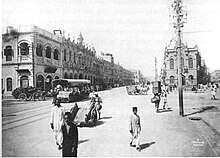
Summary
Mohamedali Tramways Company (MTC) was a transport network of rail vehicles in Karachi, Pakistan.[1]
| Mohamedali Tramways Company | |
|---|---|
 Street scene with tram in Karachi, ca. 1900. | |
| Operation | |
| Locale | Karachi, Pakistan |
| Open | April 20, 1885 |
| Close | April 30, 1975 |
| Lines | 4 |
| Owner(s) | Sheikh Mohammad Ali |
| Infrastructure | |
| Track gauge | 1,219 mm (four-foot gauge) |
| Propulsion system(s) | diesel-powered |
| Stock | 64 |
History edit
The idea of a tramway system for Karachi was conceived and a tender for its construction was first made in 1881. On February 8, 1883, a plan for a tramway was drawn up and permission obtained from the government for the use of steam-powered trams. In October 1884 construction was started. John Brunton was the Chief Engineer of the project. The tramway was opened on April 20, 1885, employing steam-powered cars. The opening ceremony took place near St Andrew's Church (Abdullah Haroon Road and Sharah-e-Liaquat).[2]
Steam Trams edit
The steam trams were replaced by horse-drawn ones in 1886.[3] In 1902 the East India Tramways Company Limited was responsible for running the trams in Karachi.
By March 23, 1905, petrol-powered tram were introduced. By 1909 the entire fleet was replaced by petrol-powered trams, unlike Europe which had switched to electric trams.[4] Each car had a capacity of 46 passengers and could travel at speeds of up to 18 mph. New tracks had to be re-laid for the petrol driven trams.[2] The trams now ran on inverted U-shaped grooved-bridge rail with a four-foot gauge.[3] The first two petrol-engined tramcars were designed by John Abbott and his son John Dixon Abbott, incorporating the Dixon-Abbott patent gearbox. They were built in England. By 1914, there were 37 petrol-powered tramcars running. 1945 saw the introduction of the first diesel-powered trams. Until 1955 there were still 64 petrol-powered trams in Karachi numbered from 94 to 157. These were single deck 4-wheeled cars with back-to-back cross benches. They had an 8 ft wheel base, and were 28 feet long, and 6 feet 8 inches wide. These cars were built between 1924 and 1948 with Perkins P.4 Diesel Engines and Simplex (Dixon-Abbott) Gearboxes. Cars number 145 to 157 were built as new diesel cars, while the rest of the cars were converted from petrol to diesel.[2]
Mohamedali Tramways Company edit
In 1949 the whole tramway system was sold to the Mohamedali Tramways Company (MTC) owned by Sheikh Mohammad Ali.[2][3]
The tram was a common mode of transport as was the horse-drawn carriage.[5] Only the elite had cars. A few young men owned motorcycles. Both men and women went about on bicycles, for this was the most common type of transport.[6] According to the nuclear scientist Abdul Qadeer Khan who lived in Karachi at the time, the tram fare in the 1950s was one anna (less than one cent).[7] Another user Ian Vaughan-Arbuckle says “You could use the trams without being jostled.”[8]
Routes edit
The original line which started operating on April 20, 1885, ran from Saddar to Kemari.
- Between 1891 and 1900 the Lawrence Road (in 2014 Nishtar Road) route was constructed.
- On September 30, 1911, the line was extended to Frere Street (in 2014 Dr. Daud Pota Road).
- On February 17, 1916, the Soldier Bazaar route was introduced via Mansfield Street (in 2014 Syedna Burhanuddin Road). October 22, 1928 saw the introduction of the Chakiwara route.
- In 1929 the line going to Soldier Bazaar from Mansfield Street was diverted to Bunder Road (in 2014 M.A. Jinnah Road).[2]
Closure edit
The trams in Karachi closed down on April 30, 1975.[2] It is not clear whether the MTC was a victim of the Karachi Circular Railway which started in 1969 with 14 trains or of the transport mafia.[9]
Possible revival edit
In 2017, a proposed plan for the renovation of the Saddar area in Karachi, has included the reintroduction of trams to ease the city's transport problems.[10] Elsewhere in the world too trams are seeing a comeback.[4]
See also edit
References edit
- ^ "Trams make their way into rehabilitation plan for Karachi downtown". www.geo.tv. Retrieved 2020-10-27.
- ^ a b c d e f Jang 4 April 2010
- ^ a b c The Friday Times 17 January 2014
- ^ a b Walmar, C. A short history of trains. Dorling Kindersley, London, 2014.
- ^ Viccaji, L. Made in Pakistan. Royal Book Company, Karachi, 2017.
- ^ Mascarenhas, Oswin (2011). The Origin and Evolution of St Lawrence's Parish, Karachi, Pakistan: The Garden Area with the Settlement of the Christian Community (Kindle Locations 809-811). Kindle Edition.
- ^ The News May 28, 2012
- ^ Dawn, February 4, 2019
- ^ Dawn February 8, 2003
- ^ Geo TV October 29, 2017


